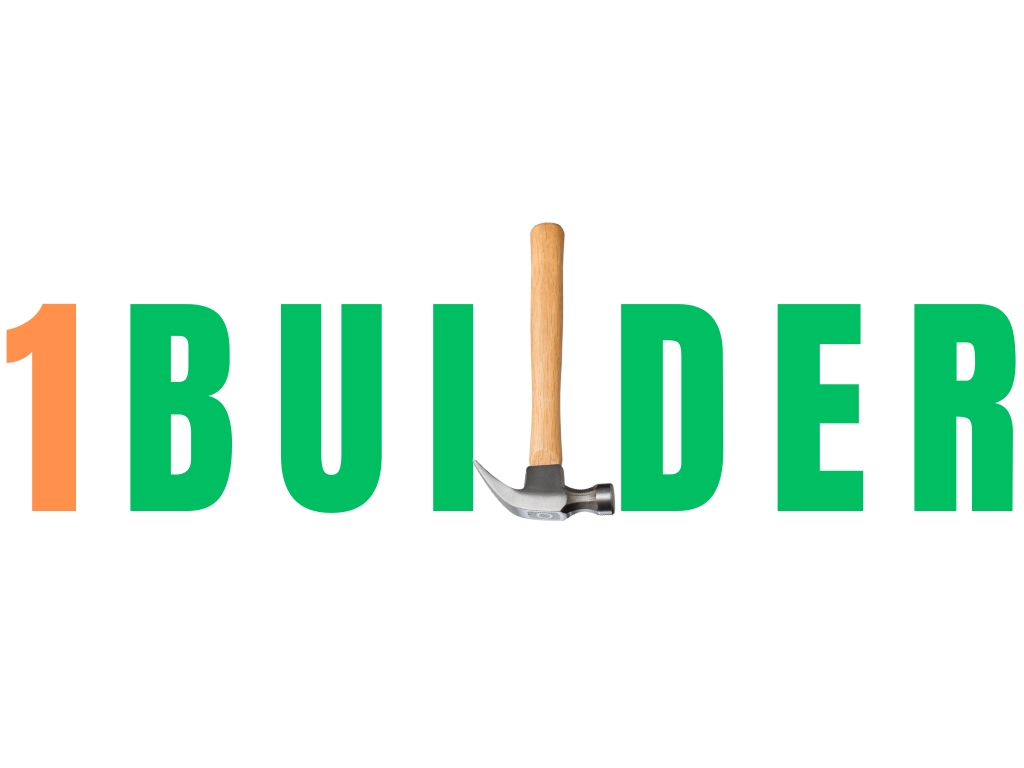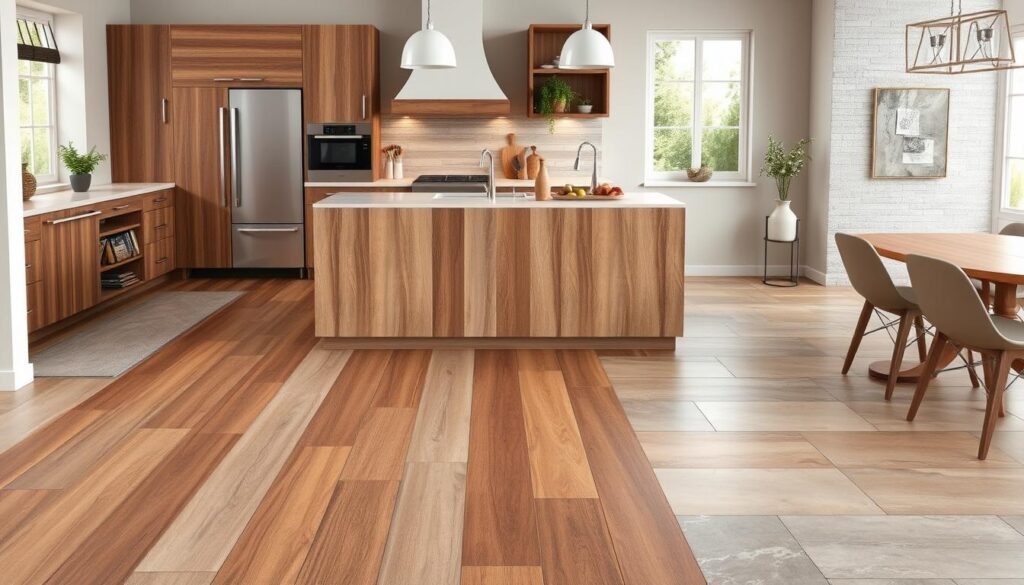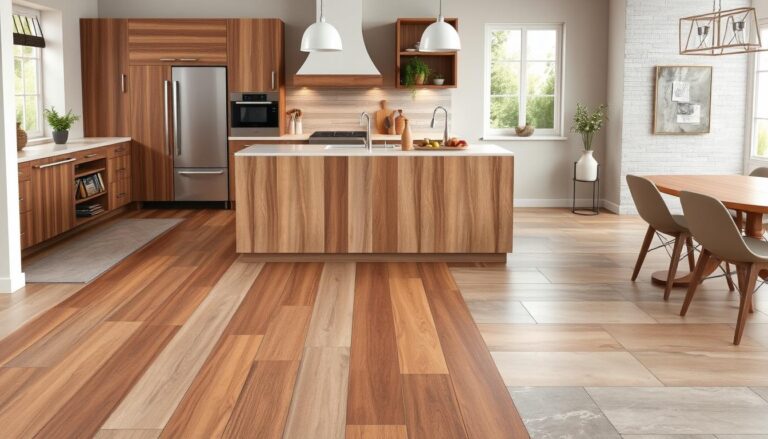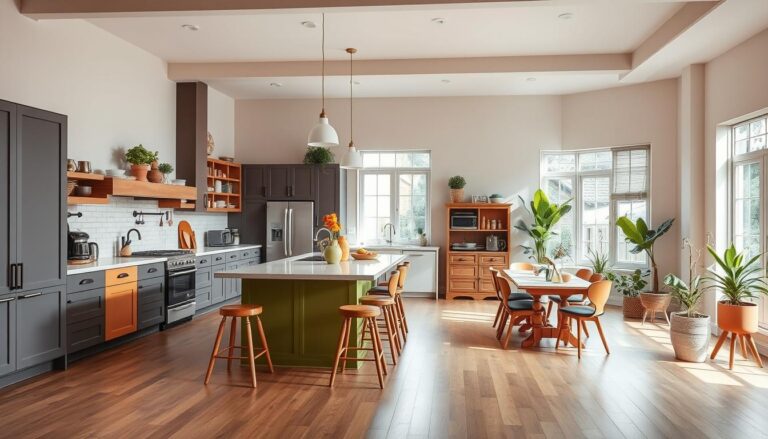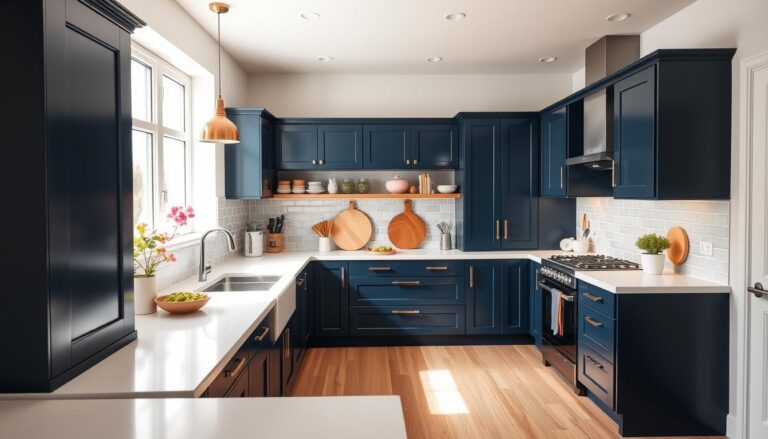Have you ever thought about why some kitchen floors last a long time while others don’t? The key is choosing the right materials. It’s not just about looks. It also involves matching them with your lifestyle, maintenance needs, and budget. Kitchens get a lot of foot traffic. So, the floors there need to be strong. They should also add value and style to your house.
Vinyl flooring is easy to take care of. It fights off stains and scratches well. Then there’s natural stone. It’s elegant and can last a long time. Each type of flooring has its own pros and cons. Knowing about the durability and upkeep of different materials is important. It helps you choose wisely for your home. When you pick high-quality materials for your kitchen floor, you get strength, comfort, and beauty all in one.
This will help your floors look good and last longer. Let’s look into the best options for kitchen floors. This way, you can pick the one that’s perfect for your home.
Key Takeaways
- Properly installed hardwood floors can boost home value by 10% to 54%.
- Porcelain tiles offer longevity exceeding 60 years with proper care.
- Vinyl flooring stands out for its durability and ease of maintenance.
- Natural stone tiles provide a sophisticated look with slip-resistant qualities.
- Ceramic tiles are praised for their versatility and longevity in kitchen settings.
Introduction to Durable Kitchen Flooring
When picking kitchen floor options, choose materials that are durable and look great. It’s important for floors to handle daily life and stay beautiful. Learn about different materials to find what’s best for maintenance, lasting value, and resistance.
Importance of Choosing the Right Material
Choosing the right material affects your kitchen’s function and look. Common choices like vinyl, ceramic, and porcelain tiles are easy to clean and resistant to water. Think about foot traffic, moisture, and cleaning when picking a material.
- Vinyl Flooring: Luxury vinyl tile (LVT) costs between $9 to $11 per square foot, offering durability and water resistance.
- Ceramic Tile: A cost-effective choice ranging from $2 to $30 per square foot, though it requires regular maintenance to prevent water absorption.
- Porcelain Tile: More durable and water-resistant than ceramic, with a higher price point due to its manufacturing costs.
Overview of Durability and Maintenance Expectations
Knowing the durability and care needed for each option helps pick the best kitchen floor. Here’s a quick look at some resilient kitchen floors:
| Material | Durability | Maintenance | Cost (per sq. ft.) |
|---|---|---|---|
| Ceramic Tile | Moderate | Regular upkeep to prevent water absorption | $2 – $30 |
| Porcelain Tile | High | Low; stain-resistant | Higher than ceramic |
| Vinyl Flooring (LVT) | High | Minimal; water-resistant | $9 – $11 |
| Laminate Flooring | Moderate | Easy to clean | $2.50 – $7 |
| Cork Flooring | Moderate | Requires sealing | $3 – $7 |
Getting durable kitchen flooring materials ensures your kitchen stays beautiful and functional. Compare the good and bad of each material. Think about cost, durability, and care. Then, pick the best floors for your style and needs.
Tile Flooring
Tile flooring is often chosen for kitchens because it’s durable and water-resistant. It’s important to look at various tile types to find their distinct advantages. This ensures you make the best choice for your kitchen.
Types of Tile Materials
There are several types of tiles suitable for kitchen floors. Common types include ceramic, porcelain, and natural stone. Each has special features that add to the floor’s durability.
- Ceramic tiles: They are affordable and resist stains and moisture well.
- Porcelain tiles: These tiles are very strong, resist water, and come in many designs.
- Natural stone tiles: They offer a unique appearance with different colors and patterns.
Benefits of Ceramic and Porcelain Tiles
Ceramic and porcelain tiles are easy to look after and last a long time. Ceramic tiles come in many styles, fitting modern kitchens perfectly. They don’t stain easily and can handle moisture, needing little care.
Porcelain tiles are harder and less porous than ceramic, making them great against water and stains. Even if they chip, their design and water resistance make them a top choice for kitchen floors.
Installation Considerations
Installing tile flooring needs careful planning. Make sure the subfloor is flat and stable to avoid cracks later. Use the right adhesive and grout to keep tiles in place. This ensures your floor stays durable and looks good.
Talking to a professional installer helps a lot. They offer tips on avoiding mistakes and choosing the best tiles for your kitchen.
Vinyl Flooring
Vinyl flooring is now a top choice for homeowners who want durable kitchen floors. It’s known for lasting a long time, having many designs, and resisting moisture. Vinyl is both practical and good-looking.
Types of Vinyl Flooring
Many kinds of vinyl flooring are out there, each unique. The most popular ones include:
- Luxury Vinyl Tiles (LVT): LVT is durable and looks high-quality. It’s easy to put in and keep up. It looks like wood and stone.
- Luxury Vinyl Planks (LVP): LVP looks like wood but is better with water. It’s a smart pick for kitchens.
- Vinyl Sheet Flooring: This kind is very good against water and doesn’t cost much. But, putting it in might need a pro for the best look.
Advantages Over Traditional Materials
Vinyl flooring beats old school materials like tile, stone, and wood. Here are the perks:
- Affordability: Vinyl costs less than other kitchen floors.
- Moisture Resistance: Vinyl doesn’t mind water, unlike laminate and hardwood. It’s perfect for kitchens.
- Comfort: It’s more comfortable to stand on vinyl and it feels warmer. This is a plus for those who cook a lot.
- Design Flexibility: Vinyl comes in tons of colors and styles. It can fit any home’s look.
Maintenance Tips for Longevity
It’s easy to keep vinyl flooring nice. Here are some quick tips:
- Sweep often to get rid of dirt that can scratch.
- Mop sometimes with a soft cloth and gentle cleaner.
- Don’t drag sharp or heavy things across the floor. It can hurt it.
- Use mats in busy spots to protect the floor even more.
Stick to these simple rules, and your vinyl floor will stay pretty and useful for a long time.
Natural Stone Flooring
Natural stone flooring adds a special elegance to any kitchen. Choices include marble, limestone, and granite. They are popular for their beauty and strength.
Popular Stone Choices
For durable kitchen floors, some top materials are:
- Marble: Looks luxurious but is soft and needs sealing to avoid stains.
- Granite: It’s tough against water because it’s not porous, making it a great choice.
- Slate: Great for avoiding slips and stains and doesn’t need sealing.
- Limestone: Must be sealed now and then but fights off viruses and molds.
- Travertine: Comes in subtle colors and needs a protective layer for lasting use.
- Sandstone: Not as tough but can last a long time with the right care.
Benefits of Stone for High-Traffic Areas
Different stones offer unique benefits for busy kitchen spots:
- Granite is very good at resisting water, which is great for kitchens.
- Slate helps prevent slips, making it safer for busy areas.
- Limestone and travertine are good at stopping germs, keeping the area clean.
Cost Considerations
The price of natural stone floors depends on the type and quality of the stone. Here is a quick price guide:
| Stone Type | Price Range (per m²) |
|---|---|
| Marble | £50 – £200 |
| Granite | £30 – £150 |
| Slate | £10 – £50 |
| Limestone | £30 – £200 |
| Travertine | £15 – £70 |
In the US, putting in natural stone floors costs between $8 to $18 per square foot. Complex designs may cost more.
Laminate Flooring
Laminate flooring is very popular for kitchens because it’s affordable, versatile, and easy to install yourself. It looks like natural wood or stone but costs less. This makes it a top choice for long-lasting kitchen floors without spending a lot.
Features of Modern Laminate
Modern laminate flooring has great features for kitchens. Its top layer is treated to resist scratches and stains. This makes laminate floors strong, perfect for areas with a lot of people walking.
They are also resistant to water. The seams are tight, which helps protect against moisture. However, you should clean up spills fast to avoid damage.
Pros and Cons of Laminate Flooring
- Pros:
- Cost-effective compared to hardwood
- Wide variety of styles and patterns
- Durable surface that resists scratches and stains
- Easy to clean and maintain
- Simple, floating installation process
- Cons:
- Susceptible to water damage if moisture seeps through seams
- Cannot be refinished once worn out
- Replacement of damaged planks can be challenging
- Not environmentally friendly due to plastic content
Installation Versus Other Materials
Installing laminate flooring is easy, making it popular for kitchens. Unlike hardwood or tile, laminate doesn’t need nails, staples, or glue. This saves trouble and cost. New lock systems make installation even easier and more flexible.
When looking at kitchen floors, consider vinyl, porcelain, and ceramic tile for their resistance to moisture. Yet, laminate’s mix of low cost, durability, and good looks stands out. For more on durable flooring in wet areas, visit this link.
Hardwood Flooring
Hardwood flooring is known for its timeless beauty. It’s a top pick for those who love classic kitchen looks. Choosing the right wood and keeping it well-maintained are key to its durability and style in kitchens.
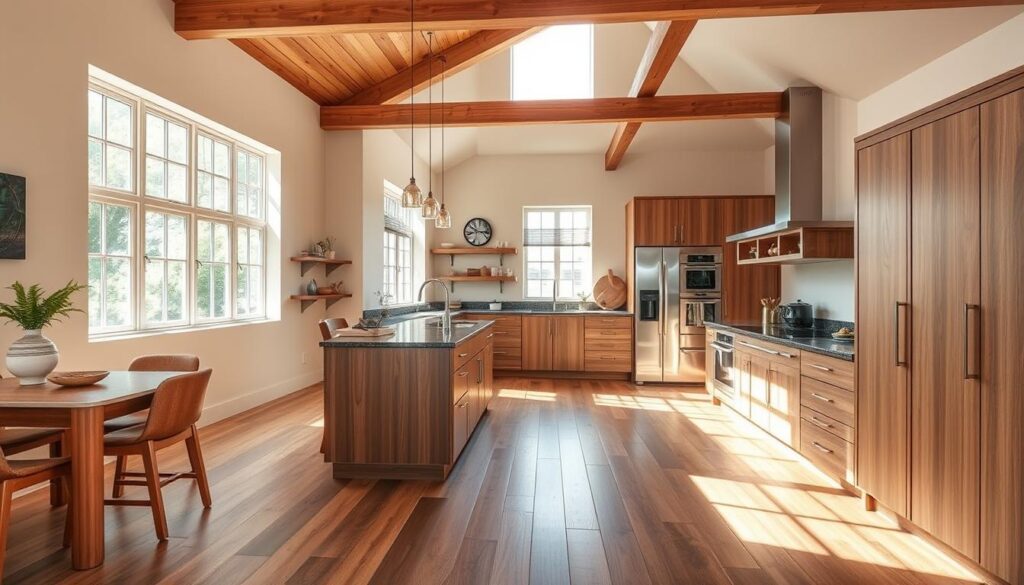
Best Wood Types for Kitchen Floors
Engineered wood is often better for kitchens than solid hardwood. This is because it’s more stable and better at handling moisture. Oak, maple, and cherry are great for their strength and beauty. Using reclaimed wood can also bring a unique and eco-friendly touch to your kitchen.
Maintenance and Care for Durability
Keeping hardwood floors in good shape in kitchens needs careful attention. A properly finished floor is somewhat protected against moisture, but you must keep it dry. Quickly clean up spills to avoid water damage.
Use wood-friendly cleaners like Tarkett Refresher. And plan on re-sanding and refinishing your floors every 10 to 20 years. Doing this will help your floors last longer, especially in kitchens.
Environmental Considerations
It’s good to choose sustainable hardwood flooring options. Go for certified wood from well-managed forests to support the environment. Reclaimed wood is another great choice. It gives your kitchen character, supports recycling, and lessens the need for new wood. These choices might cost more upfront but are worth it for their durability and eco-friendliness.
For a deeper look into remodeling your kitchen with quality flooring, check out Italia Kitchens Construction. They can give you a detailed review of your options.
Cork Flooring
Cork flooring is both eco-friendly and comfortable, making it a top choice for kitchens. It comes from the cork oak tree’s bark. This makes it a green choice for an eco-conscious kitchen.
Unique Properties of Cork
Cork floors are great because they insulate against noise and cold. This means a quieter, warmer kitchen. This material fights off mold, bugs, and mildew too. It’s good for keeping your home healthy.
Typically, cork flooring is priced from $3 to $9 per square foot. Adding professional installation costs $2 to $4 per square foot for floating floors. Glue-down installation may cost double.
Resilience and Comfort Underfoot
Cork is known for being soft and comfy. It’s gentle on your feet and joints. This is a big plus for those who love to cook and stand a lot.
It’s also very long-lasting. With the right care, cork floors can last over 40 years. But, you should watch out for scratches and dents from heavy furniture.
Ideal Use Cases for Kitchens
Cork flooring is perfect for kitchens because it’s low-maintenance and easy to install yourself. You just need some thin foam pads underneath. Keeping it sealed every 5 to 7 years keeps moisture out. Regular cleaning keeps it looking great.
Brands like Globus Cork Flooring and WE Cork offer many choices. They meet both style and function needs in kitchen flooring. iCork Floor and Heritage Mill are also great options to consider.
Concrete Flooring
Concrete flooring is getting more popular in kitchens. It’s known for lasting a long time with little upkeep. Homeowners looking for durable floors find concrete a great choice.
Advantages of Using Concrete
Concrete floors are tough. They handle busy areas like kitchens well and last for decades. They don’t easily chip, change color, warp, or stain. This makes them top picks for durable kitchen floors.
Once sealed, they resist water damage too. This keeps them safe from moisture.
Customization and Design Options
Concrete floors can be customized. Homeowners can pick colors, patterns, and more to match their style. You can even put high-quality digital images on floors.
Businesses can have their logos put on concrete floors. This makes them good for both homes and stores.
| Feature | Details |
|---|---|
| Durability | Highly durable, lasting several decades |
| Water Resistance | Excellent once sealed |
| Maintenance | Minimal, but requires sealing |
| Design Options | Customizable with colors, patterns, stenciling, and engraving |
| Applications | Residential and commercial |
Long-Term Durability Factors
The durability of concrete floors depends on several things. Using enough rebar is one key factor. Proper sealing stops moisture damage and stains.
Even though concrete lasts long, changing it later can be expensive. But, its long life makes it a budget-friendly option over time.
Rubber Flooring
Rubber flooring is now a top choice for kitchens. It’s safe, long-lasting, and easy to keep clean. It’s great for homes and business kitchens alike. It promises a long-lasting flooring for kitchens.
Benefits in Residential and Commercial Kitchens
Rubber flooring brings many benefits to kitchens:
- Slip Resistance: Rubber mats are anti-slip, making kitchens safer.
- Durability: They last longer, especially those with natural rubber.
- Ease of Cleaning: They resist water and stains, so they’re easy to clean.
- Eco-Friendly: Many are made sustainably, good for our planet.
Safety and Comfort Features
Rubber floors are not just tough; they’re also safe and comfy. They prevent slips in busy kitchens. The rubber contains Nitrile, making it resist grease. This means less risk of spills.
They’re also comfy to stand on for a long time. This reduces tiredness in kitchens. It’s a big plus for anyone cooking or working there.
Installation Process and Costs
Putting in rubber flooring is easy, perfect for quick kitchen updates. Dura-Rubber’s liquid coating gives a smooth finish. It stands up well to kitchen messes, heavy use, and big temperature changes.
It comes in many colors and styles to match any decor:
| Material | Cost per Square Foot (installed) |
|---|---|
| Porcelain and Ceramic Tile | $5-$20 |
| Natural Stone Tile | $15-$50 |
| Engineered Wood Flooring | $4-$8 |
| Solid Wood Flooring | $8-$15 |
| Exotic Hardwood Flooring | $10-$18 |
| Luxury Vinyl Plank | $3-$8 |
| Sheet Vinyl | $2-$4 |
| Cork Flooring | $7-$12 |
| Laminate Flooring | $3-$7 |
| Concrete Flooring | $4-$10 |
| Rubber Flooring | $7-$15 |
| Bamboo Flooring | $6-$12 |
Rubber floors cost $7 to $15 per square foot to install. Dura-Rubber is quick to apply and dries fast. It’s ready in 24-48 hours. This makes it perfect for busy places.
Comparison of Kitchen Flooring Options
Choosing the right materials for kitchen floors is crucial. You need to look at durability, cost, and how it looks. This part will compare them to help you decide wisely.
Durability Ratings Across Different Materials
Different flooring options last for various lengths of time. Knowing this helps you pick the right one for your kitchen.
| Flooring Type | Durability | Maintenance |
|---|---|---|
| Luxury Vinyl Plank (LVP) | High | Low |
| Ceramic Tile | Very High | Low |
| Hardwood | High | Moderate |
| Natural Stone | Very High | Moderate |
| Laminate | Moderate | Low |
Cost Analysis: Short-term vs. Long-term Investment
Choosing the right kitchen floor isn’t just about the up-front cost. It’s about how much you save in the long run.
| Flooring Type | Initial Cost per Sq Ft | Long-term Investment |
|---|---|---|
| Luxury Vinyl Plank (LVP) | $3 – $4+ | High |
| Ceramic Tile | $4 or less | Very High |
| Hardwood | $4 – $12 | Very High |
| Natural Stone | Similar to Hardwood | High |
| Laminate | Cost-effective | Moderate |
Aesthetic Considerations for Kitchen Designs
Looks matter as much as durability and cost. The right kitchen floor must look good with your design.
- Luxury Vinyl Plank (LVP): Comes in many styles. It’s great for various looks with its bright colors and patterns.
- Ceramic Tile: Has many colors and designs. Large tiles and bold statements are trending.
- Hardwood: Always classy, works well in many types of kitchens. Light colors make spaces seem bigger.
- Natural Stone: Gives a rustic and elegant feel. Materials like travertine have unique textures.
- Laminate: A cost-effective choice that can mimic hardwood and tile for a stylish look.
Conclusion: Making the Right Choice
Finding the ideal kitchen flooring is about balance. You must look at durability, style, ease of upkeep, and your budget. Options range from luxurious hardwood to practical vinyl. Each has unique benefits for different lifestyles and design wishes. Knowing these can help pick the best flooring for your home.
Factors to Consider When Choosing Flooring
Think about how tough and moisture-resistant a floor needs to be. Also, consider if it’s easy to keep clean and matches your kitchen’s look. Engineered wood, vinyl, and both ceramic and porcelain tiles are durable. They resist wear and tear, standing out as top choices for kitchens.
Luxury vinyl tile (LVT) and vinyl rolls are especially good against moisture and simple to clean. They come in many designs that look like wood or stone. This makes them practical yet stylish for your kitchen.
Final Thoughts on Durability and Style
Picking materials that can handle a busy kitchen and moisture while still looking good is crucial. You might like the warm look of engineered wood or the sleek style of luxury vinyl tile. Your choice should meet your needs and fit the kitchen’s look. Focus on scratch resistance, moisture protection, and low maintenance to keep your floor looking great.
The best flooring choice makes your kitchen welcoming and durable. It should match the kitchen’s style and your lifestyle perfectly. In the end, the right floor will make your kitchen truly the heart of your home.
FAQ
What are the best materials for durable kitchen floors?
The top choices for lasting kitchen floors are vinyl, ceramic, porcelain, and natural stone. Also popular are laminate, hardwood, cork, concrete, and rubber. Each material offers unique advantages in terms of care, strength, and design appeal.
How do I choose the right kitchen flooring material?
When picking a kitchen flooring material, think about your daily life, home look, upkeep needs, and budget. Check how well the material stands up to wear, environment, and if it matches your kitchen’s use and style.
What are the benefits of tile flooring in the kitchen?
Tile flooring, particularly ceramic and porcelain, is very durable and water-resistant. Tile is easy to care for. Plus, it comes in lots of styles and colors, fitting various kitchen designs.
How does vinyl flooring compare with traditional materials?
Vinyl flooring, like Luxury Vinyl Tiles (LVT) and planks (LVP), offers great durability, style variety, and is pretty affordable. It stands up well to stains and scratches. Plus, it’s easier to look after than natural stone or hardwood.
What types of natural stone are popular for kitchen flooring?
Marble, limestone, and granite are popular choices for kitchen floors. These stones are elegant and durable. Yet, they need regular upkeep like sealing and careful cleaning to avoid damage.
What are the pros and cons of laminate flooring in the kitchen?
Laminate flooring is budget-friendly, easy to install yourself, and looks like hardwood or stone. However, it’s not very water-resistant. This is something to consider for kitchen usage.
What maintenance is required for hardwood kitchen floors?
Hardwood floors in the kitchen need regular care like sealing for more water resistance. You should clean them carefully to prevent damage from moisture and temperature changes. This maintains their long-lasting beauty and performance.
Why is cork flooring considered eco-friendly?
Cork flooring is eco-friendly because it comes from the bark of cork oak trees without harming them. Cork is comfy to stand on, offers good bounce back and quietness. Yet, it must be sealed to avoid moisture damage.
What are the advantages of using concrete flooring in kitchens?
Concrete flooring is super durable and easy to maintain. It can be designed uniquely through staining and polishing. To ensure it’s water-resistant and stain-free, it should be sealed. This makes concrete a great, long-lasting choice for kitchens.
How does rubber flooring benefit kitchen environments?
Rubber flooring is slip-resistant, feels comfortable to stand on, and is easy to put in. This flooring is a smart choice for both home and professional kitchens. It’s also easy to maintain and perfect for safe, long-wearing use.
How do different kitchen flooring materials compare in terms of durability and cost?
Durability and cost widely vary across flooring choices. Vinyl and ceramic are both affordable and long-lasting. Natural stone and hardwood are more durable but costlier. Meanwhile, laminate and cork are less expensive options with decent durability. It’s important to weigh their long-term value and how they will look in your kitchen.
Source Links
- https://bossdesigncenter.com/what-is-the-best-flooring-for-a-kitchen/
- https://www.lxhausys.com/us/blog/the-most-durable-7-options-for-kitchen-flooring/
- https://www.lxhausys.com/us/blog/what-is-the-best-flooring-for-a-kitchen/
- https://www.compellinghomes.com/blog/essential-guide-to-stylish-and-durable-kitchen-floor-tile
- https://hometownstone.com/best-kitchen-flooring-material/
- https://www.homesandgardens.com/kitchens/which-kitchen-floor-tiles-are-best
- https://www.lxhausys.com/us/blog/what-type-of-floor-tile-is-best-for-a-kitchen/
- https://www.flooranddecor.com/blogs/the-best-floor-for-your-kitchen.html?srsltid=AfmBOoofxeLuCzzEVLlZ0xkY_v7D_JJyOaFwUOhEiP0Zxb3kixbQfZsM
- https://home.tarkett.com/en_EU/node/choosing-vinyl-floors-for-a-kitchen-9277
- https://www.flooringstores.com/a/blog/best-kitchen-vinyl-plank-flooring?srsltid=AfmBOor30dIDkZHUk-vMRHzmIgYVunpDezdzGOwp4EhE9l4I2pA7HMiQ
- https://123remodeling.com/blog/natural-stone-6-beautiful-durable-options-for-your-kitchen-floor/
- https://www.mystonefloor.com/blogs/blog/natural-stone-flooring-ideas
- https://www.realhomes.com/buying-guides/how-to-choose-real-stone-flooring
- https://home.tarkett.com/en_EU/node/choosing-laminate-flooring-kitchen-9279
- https://www.avalonflooring.com/blogs/blog/pros-and-cons-of-laminate-in-your-kitchen
- https://www.goodhousekeeping.com/home-products/g42157811/best-laminate-flooring/
- https://home.tarkett.com/en_EU/node/choosing-wood-floors-kitchen-9278
- https://bonsaibuilds.com/the-best-modern-kitchen-flooring-options-to-consider/
- https://www.thespruce.com/cork-flooring-pros-and-cons-1314688
- https://remodelworks.com/blog/cork-flooring-kitchen-pros-cons/
- https://www.alairhomes.com/solon/blog/guide-to-concrete-flooring-in-your-custom-home-kitchen/
- https://www.concretenetwork.com/concrete/interiorfloors/kitchen.html
- https://rubberflooringexperts.com/commercial-buyers-guide/kitchen-floor-mats/
- https://rubberizeit.com/pages/kitchen-floor?srsltid=AfmBOorPTFf1T5RE5MYZtoQb8dVCnyHgm0IqFohgC4X72p1ZPi4pygKN
- https://www.usacabinetstore.com/best-kitchen-flooring-options/
- https://kowalske.com/types-of-flooring/
- https://www.houzz.com/magazine/pros-and-cons-of-5-popular-kitchen-flooring-materials-stsetivw-vs~58148076
- https://home.tarkett.com/en_EU/node/what-best-flooring-kitchen-9280
- https://www.piedmontfloorshow.com/blog/articles/what-is-the-best-flooring-for-a-kitchen
